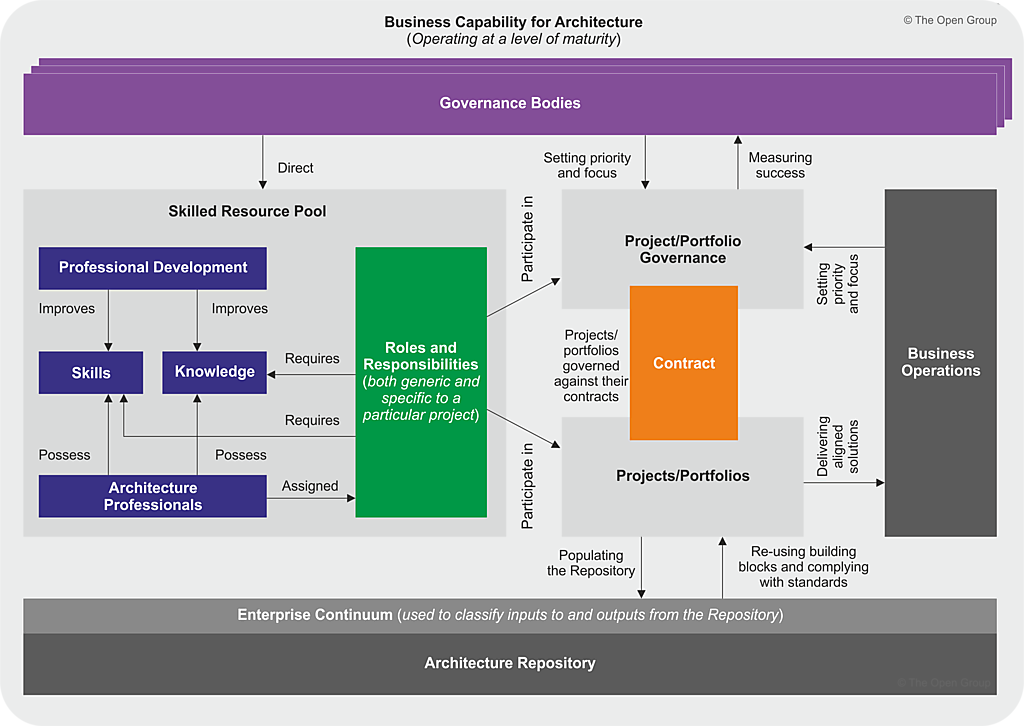Introduction:
In the ever-evolving landscape of enterprise architecture, organizations seek frameworks that can guide them through the complexities of designing and implementing effective architectures. One such robust framework is TOGAF, and at its core lies a powerful tool—the Architecture Capability Framework. This framework is a comprehensive set of resources, guidelines, templates, and background information strategically designed to empower architects in establishing and nurturing a thriving architecture practice within an organization.
Understanding the Architecture Capability Framework:
At the heart of TOGAF’s guidance lies the Architecture Capability Framework, a carefully crafted set of tools that addresses the challenges architects face in developing and sustaining an architecture practice. This framework is not a one-size-fits-all solution; rather, it provides a flexible and adaptable structure that can be tailored to suit the unique needs and goals of an organization.

Key Components:
Resources:
The Architecture Capability Framework offers a repository of resources that architects can leverage in their practice. These resources encompass a wide range of materials, including reference models, architecture patterns, and best practices. By tapping into this wealth of information, architects can make informed decisions and accelerate the development of robust architectures.
Guidelines:
TOGAF’s Architecture Capability Framework provides clear and concise guidelines to help architects navigate the complexities of architecture development. These guidelines cover various aspects, including the creation of architecture visions, the development of architecture roadmaps, and the establishment of governance structures. Following these guidelines ensures a systematic and standardized approach to architecture development.
Templates:
To streamline the architecture development process, the framework includes a collection of templates. These templates serve as starting points for architects, offering a structured framework for documenting and communicating architectural artifacts. By utilizing these templates, architects can save time and ensure consistency across different projects.
Background Information:
Understanding the context in which architecture is developed is crucial for architects. The Architecture Capability Framework provides background information that delves into the foundational concepts of architecture development. This knowledge equips architects with a deeper understanding of the principles and rationale behind architectural decisions.
Benefits of the Architecture Capability Framework:
Establishing Consistency:
One of the primary advantages of the Architecture Capability Framework is its ability to foster consistency in architecture development. By providing standardized guidelines and templates, the framework ensures that architectural artifacts are aligned with organizational goals and adhere to established best practices.
Accelerating Time-to-Value:
With a rich repository of resources and pre-defined templates, architects can expedite the architecture development process. This acceleration translates to faster time-to-value, enabling organizations to respond more swiftly to changing business needs and market dynamics.
Facilitating Continuous Improvement:
The Architecture Capability Framework is not a static set of guidelines; it evolves to accommodate industry trends and emerging best practices. This facilitates continuous improvement in an organization’s architecture practice, ensuring that architects are equipped with the latest tools and methodologies.
Conclusion:
In the realm of enterprise architecture, the Architecture Capability Framework within TOGAF stands as a beacon for architects navigating the complexities of architecture development. With its comprehensive set of resources, guidelines, templates, and background information, this framework empowers organizations to establish and sustain a mature and effective architecture practice. By embracing the Architecture Capability Framework, architects can chart a course towards architectural excellence and contribute significantly to their organization’s success in a rapidly changing business landscape.